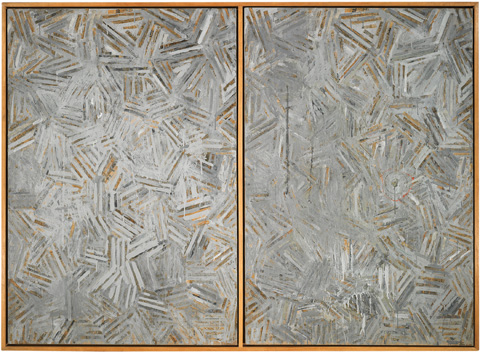
ENCRYPTED Jasper Johns pieces like The Dutch Wives contradicted the Abstract Expressionist ideals
of virtuoso originality and self-revelation. |
The title of Jasper Johns's 1975 painting The Dutch Wives refers to a slang term for, alternately, a prostitute or sex doll or a glory hole. As the starting point for "Jasper Johns/In Press: The Crosshatch Works and the Logic of Print" at the Harvard Art Museums (485 Broadway, Cambridge, through August 18), it signals the modern master's twin strategies.
> SLIDESHOW: ''Jasper Johns / In Press: The Crosshatch Works &the Logic of Print'' <
First, the core of Johns's work is visual games and optical illusions, often producing philosophical conundrums. His breakthrough 1950s canvases painted like American flags were also in essence flags themselves. Or were they? Second, the gay artist often makes coded sexual references, decipherable to those in the know, but hidden to the homophobic mainstream.
Dutch Wives is two paired canvases whose abstract patterns of gray encaustic hatching are near copies of each other, right down to collaged identical newspaper clippings underneath. Note that the title is plural — wives — suggesting that neither canvas is the "original," that both are theoretically copies. This undermining of originality multiplies when you look across the gallery to Johns's 1977 The Dutch Wives screenprint, a pretty faithful copy of the painting (most Johns prints imitate previous paintings), down to the faux newspaper collage printed underneath.
Meanwhile, a queer reading of the title might prompt tangential thoughts of anonymous gay sex at New York piers or perhaps the inadequacy of traditional roles like husband and wife to describe gay coupling.
To the curators — Harvard professor Jennifer Roberts; four of her undergraduate students, Jacob Cedarbaum, C. Andrew Krantz, Mary Potter, and Phillip Zhang; Harvard PhD candidate Jennifer Quick; and Harvard curator Susan Dackerman — Dutch Wives prompts unremarkable analysis of how printmaking inspired repetition, copying, and mirroring (much the way prints often are reverse images of their source plates) in Johns's art. Try to ignore their repeated misunderstanding of printing techniques (for instance, their suggestion that lithography is one of the "most physical" forms of printmaking, something that would be disputed by anyone who's tried it). The small show (15 Johns works from 1960 to '95 plus a handful things by Dürer, Picasso, Stella) reminds how Johns's prints leach out the textures, dimension, and color that make his paintings sensually attractive, creating works that are grim and uptight.
Johns is one of the iconic artists of the 1950s and '60s because he pioneered the shift from the passionate, macho improvisation of Abstract Expressionist painting by Jackson Pollock, Willem de Kooning, and friends to a more cerebral, conceptual, and — in his case — gay cool. While de Kooning was saying things like "Flesh is the reason oil paint was invented," the methodical Johns was writing, "Take an object. Do something to it. Do something else to it." Throughout his career, Johns made paintings and prints like The Dutch Wives with drippy marks that look improvisational, but he filled sketchbooks beforehand planning out their intricate patterns. The repetition and mirroring might be inspired by printing, but they also aim to contradict Ab-Ex ideals of virtuoso originality.